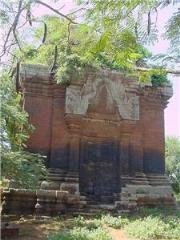Thursday, 05 Oct 2006
Cambodia may be better known for its recent brutal history than the glory of its ancient past, but it offers the intrepid visitor a chance to see a country relatively undiscovered by the majority of tourists.
For travellers keen to explore this heritage, and see one of the seven wonders of the world, Cambodia's Siem Reap region is the place to go.
The Khmer civilisation of Angkor was responsible for making Cambodia one of the region's richest, biggest and most prosperous countries from the ninth to 13th centuries, as well as creating a great many sculptures, inscriptions, temples and monuments.
It was also during this time that the Khmers built the Angkor Wat temple - one of the seven wonders of the world.
Taking more than 30 years to build, the temple is the largest stone-structure temple in the world, with 4,000 elephants and 380,000 men thought to have been involved in its creation.
Despite its mammoth size, almost every stone used for the temple has been embellished with decorative carvings.
Close to site of the temple is Angkor Thom City, once one of the most modern cities in the world, more than 30 times bigger than London around the same 12th-century period.
At the site visitors can see ancient water reservoirs, irrigation systems, highways and bridges, all dating back to 800 years ago.
The former capital city is all the more remarkable for its commercial capabilities. Using the wealth of natural resources located close by, Angkor was able to harvest enough rice to feed 800,000 inhabitants, while still leaving 40 per cent for other areas throughout the kingdom.
For travellers keen to explore this heritage, and see one of the seven wonders of the world, Cambodia's Siem Reap region is the place to go.
The Khmer civilisation of Angkor was responsible for making Cambodia one of the region's richest, biggest and most prosperous countries from the ninth to 13th centuries, as well as creating a great many sculptures, inscriptions, temples and monuments.
It was also during this time that the Khmers built the Angkor Wat temple - one of the seven wonders of the world.
Taking more than 30 years to build, the temple is the largest stone-structure temple in the world, with 4,000 elephants and 380,000 men thought to have been involved in its creation.
Despite its mammoth size, almost every stone used for the temple has been embellished with decorative carvings.
Close to site of the temple is Angkor Thom City, once one of the most modern cities in the world, more than 30 times bigger than London around the same 12th-century period.
At the site visitors can see ancient water reservoirs, irrigation systems, highways and bridges, all dating back to 800 years ago.
The former capital city is all the more remarkable for its commercial capabilities. Using the wealth of natural resources located close by, Angkor was able to harvest enough rice to feed 800,000 inhabitants, while still leaving 40 per cent for other areas throughout the kingdom.


























No comments:
Post a Comment